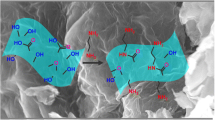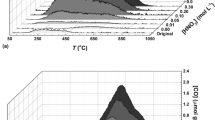Abstract
Graphitic carbon nitride (g-C3N4) was explored as a sorbent for the emulsification-enhanced (EE) disposable pipette extraction (DPX) of eight organochlorine pesticides (OCPs) from environmental waters. The OCPs, including α-hexachlorocyclohexane, Aldrin, α-Chlordane, Dieldrin, 4,4′-dichlorodiphenyldichloroethylene, 4,4′-dichlorodiphenyldichloroethane, Heptachlor and Heptachlor epoxide (Isomer A), were analyzed by gas chromatography-mass spectrometry. The sorbent g-C3N4 was characterized by elemental analysis, X-ray diffraction, scanning electron microscopy, Fourier-transform infrared and Raman spectroscopy. As a C-N analogue of graphite, g-C3N4 exhibits good water dispersibility and allows easy analyte recovery – a characteristic not commonly observed in carbon-based materials. When applied to DPX, g-C3N4 rapidly establishes strong interactions with the OCPs. Consequently, g-C3N4 displays superior extraction capability in comparison to six other commercial sorbents. An emulsification step prior to DPX was found to enhance the overall extraction efficiency by pre-concentrating the OCPs into the microdroplets of an organic solvent. The microdroplets were then adsorbed onto g-C3N4. Under the most favorable conditions, wide linear responses spanning over two to four orders of magnitudes are established. The limits of detection range between 2.4 ng·L−1 and 46.2 ng·L−1. The method is reproducible (relative standard deviations ≤ 7.4%) and enrichment factors are between 42 and 57. When applied to the analysis of lake and river water samples, EE-DPX-gas chromatography-mass spectrometry exhibits good resilience against matrix interferences. The relative recoveries range between 77.7% and 106.3%. In comparison to other sorbent-based extraction techniques reported for the analysis of OCPs in aqueous samples, EE-DPX utilizes the minimal amount of sample and solvent, and requires the shortest sample preparation time.

Schematic representation of the emulsification-enhanced disposable pipette extraction (DPX) of organochlorine pesticides (OCPs) using graphitic carbon nitride (g-C3N4) as sorbent. Emulsification and DPX work synergistically, thus allowing rapid dissolution of analytes into microdroplets of organic solvent, before being extracted by g-C3N4.



Similar content being viewed by others
References
Tang S, Chia GH, Chang Y, Lee HK (2014) Automated dispersive solid-phase extraction using dissolvable Fe3O4-layered double hydroxide core-shell microspheres as sorbent. Anal Chem 86(22):11070–11076. https://doi.org/10.1021/ac503323e
Chen Z, Yu C, Xi J, Tang S, Bao T, Zhang J (2019) A hybrid material prepared by controlled growth of a covalent organic framework on amino-modified MIL-68 for pipette tip solid-phase extraction of sulfonamides prior to their determination by HPLC. Microchim Acta 186(6):393. https://doi.org/10.1007/s00604-019-3513-7
Tan SC, Lee HK (2019) A hydrogel composite prepared from alginate, an amino-functionalized metal-organic framework of type MIL-101(Cr), and magnetite nanoparticles for magnetic solid-phase extraction and UHPLC-MS/MS analysis of polar chlorophenoxy acid herbicides. Microchim Acta 186(8):545. https://doi.org/10.1007/s00604-019-3679-z
Guan H, Brewer WE, Garris ST, Craft C, Morgan SL (2010) Multiresidue analysis of pesticides in fruits and vegetables using disposable pipette extraction (DPX) and micro-luke method. J Agric Food Chem 58(10):5973–5981. https://doi.org/10.1021/jf903448w
Xu N, Wang Y, Rong M, Ye Z, Deng Z, Chen X (2014) Facile preparation and applications of graphitic carbon nitride coating in solid-phase microextraction. J Chromatogr A 1364:53–58. https://doi.org/10.1016/j.chroma.2014.08.081
Ding X, Zhu J, Zhang Y, Xia Q, Bi W, Yang X, Yang J (2016) Separation and concentration of natural products by fast forced adsorption using well-dispersed velvet-like graphitic carbon nitride with response surface methodology optimisation. Talanta 154:119–126. https://doi.org/10.1016/j.talanta.2016.03.065
Huang J, Zhang X, Song H, Chen C, Han F, Wen C (2018) Protonated graphitic carbon nitride coated metal-organic frameworks with enhanced visible-light photocatalytic activity for contaminants degradation. Appl Surf Sci 441:85–98. https://doi.org/10.1016/j.apsusc.2018.02.027
Nian Q, Wang X, Wang M, Zuo G (2019) A hybrid material composed of graphitic carbon nitride and magnetite (Fe3O4) for magnetic solid-phase extraction of trace levels of hydroxylated polycyclic aromatic hydrocarbons. Microchim Acta 186(8):497–505. https://doi.org/10.1007/s00604-019-3607-2
Marzi Khosrowshahi E, Matin AA (2019) A monolithic graphitic carbon nitride/polyethersulfone nanocomposite: an application of a mixed matrix membrane as a solid-phase microextraction fiber. Microchim Acta 186(10):679. https://doi.org/10.1007/s00604-019-3786-x
Grossi P, Olivares IR, de Freitas DR, Lancas FM (2008) A novel HS-SBSE system coupled with gas chromatography and mass spectrometry for the analysis of organochlorine pesticides in water samples. J Sep Sci 31(20):3630–3637. https://doi.org/10.1002/jssc.200800338
World Health Organization (2017) Guidelines for drinking-water quality. Fourth Edition Incorporating the First Addendum
European Union (1998) EU Council directive 98/83/EC of 3 November 1998 on the quality of water intended for human consumption. Off J Eur Commun L330:32–54
European Union (2006) Directive 2006/118/EC of the European parliament and of the council of 12 December 2006 on the protection of groundwater against pollution and deterioration. Off J Eur Commun L372:19–31
Huang Z, Chua PE, Lee HK (2015) Carbonized polydopamine as coating for solid-phase microextraction of organochlorine pesticides. J Chromatogr A 1399:8–17. https://doi.org/10.1016/j.chroma.2015.04.028
Brondi SHG, Spoljaric FC, Lanças FM (2005) Ultratraces analysis of organochlorine pesticides in drinking water by solid phase extraction coupled with large volume injection/gas chromatography/mass spectrometry. J Sep Sci 28(17):2243–2246. https://doi.org/10.1002/jssc.200500034
Feng X, Tian M, Li A, Zhao X, Zhang Y (2010) Multiwalled carbon nanotube coated on stainless steel wire for solid-phase microextraction of organochlorine pesticides in water. Anal Lett 43(16):2477–2486. https://doi.org/10.1080/00032711003731407
Li D, Zhu J, Wang M, Bi W, Huang X, Chen DD (2017) Extraction of trace polychlorinated biphenyls in environmental waters by well-dispersed velvet-like magnetic carbon nitride nanocomposites. J Chromatogr A 1491:27–35. https://doi.org/10.1016/j.chroma.2017.02.048
Wu T, Wang J, Liang W, Zang X, Wang C, Wu Q, Wang Z (2017) Single layer graphitic carbon nitride-modified graphene composite as a fiber coating for solid-phase microextraction of polycyclic aromatic hydrocarbons. Microchim Acta 184(7):2171–2180. https://doi.org/10.1007/s00604-017-2233-0
Luo YB, Yuan BF, Yu QW, Feng YQ (2012) Substrateless graphene fiber: a sorbent for solid-phase microextraction. J Chromatogr A 1268:9–15. https://doi.org/10.1016/j.chroma.2012.10.035
Y-p S, Ha W, Chen J, H-y Q, Y-p S (2016) Advances and applications of graphitic carbon nitride as sorbent in analytical chemistry for sample pretreatment: a review. Trends Anal Chem 84:12–21. https://doi.org/10.1016/j.trac.2016.03.002
Fowkes FM (1964) Dispersion force contributions to surface and interfacial tensions, contact angles, and heats of immersion. In: Fowkes FM (ed) Contact angle, wettability, and adhesion, vol 43. American Chemical Society, pp 99–111. https://doi.org/10.1021/ba-1964-0043.ch006
Wang B, Wang H, Zhong X, Chai Y, Chen S, Yuan R (2016) A highly sensitive electrochemiluminescence biosensor for the detection of organophosphate pesticides based on cyclodextrin functionalized graphitic carbon nitride and enzyme inhibition. Chem Commun (Camb) 52(28):5049–5052. https://doi.org/10.1039/c5cc10491b
Guan H, Brewer WE, Garris ST, Morgan SL (2010) Disposable pipette extraction for the analysis of pesticides in fruit and vegetables using gas chromatography/mass spectrometry. J Chromatogr A 1217(12):1867–1874. https://doi.org/10.1016/j.chroma.2010.01.047
Zhang Y, Lee HK (2012) Application of ultrasound-assisted emulsification microextraction based on applying low-density organic solvent for the determination of organochlorine pesticides in water samples. J Chromatogr A 1252:67–73. https://doi.org/10.1016/j.chroma.2012.06.065
Han Q, Wang Z, Xia J, Xia L, Chen S, Zhang X, Ding M (2013) Graphene as an efficient sorbent for the SPE of organochlorine pesticides in water samples coupled with GC-MS. J Sep Sci 36(21–22):3586–3591. https://doi.org/10.1002/jssc.201300373
Gülbakan B, Uzun C, Çelikbıçak Ö, Güven O, Salih B (2008) Solid phase extraction of organochlorine pesticides with modified poly (styrene-divinylbenzene) microbeads using home-made solid phase extraction syringes. React Funct Polym 68(2):580–593. https://doi.org/10.1016/j.reactfunctpolym.2007.10.014
Mehdinia A (2014) Preconcentration and determination of organochlorine pesticides in seawater samples using polyaniline/polypyrrole-cellulose nanocomposite-based solid phase extraction and gas chromatography-electron capture detection. J Braz Chem Soc 25(11):2048–2053. https://doi.org/10.5935/0103-5053.20140190
Zhang S, Du Z, Li G (2013) Metal-organic framework-199/graphite oxide hybrid composites coated solid-phase microextraction fibers coupled with gas chromatography for determination of organochlorine pesticides from complicated samples. Talanta 115:32–39. https://doi.org/10.1016/j.talanta.2013.04.029
Zhou Q, Huang Y, Xiao J, Xie G (2011) Micro-solid phase equilibrium extraction with highly ordered TiO2 nanotube arrays: a new approach for the enrichment and measurement of organochlorine pesticides at trace level in environmental water samples. Anal Bioanal Chem 400(1):205–212. https://doi.org/10.1007/s00216-011-4788-7
Taghani A, Goudarzi N, Bagherian G (2016) Application of multiwalled carbon nanotubes for the preconcentration and determination of organochlorine pesticides in water samples by gas chromatography with mass spectrometry. J Sep Sci 39(21):4219–4226. https://doi.org/10.1002/jssc.201600555
Doyle MP, Siegfried B, Dellaria JF Jr (1977) Alkyl nitrite-metal halide deamination reactions. 2. Substitutive deamination of arylamines by alkyl nitrites and copper(II) halides. A direct and remarkably efficient conversion of arylamines to aryl halides. J Org Chem 42(14):2426–2431. https://doi.org/10.1021/jo00434a017
Brewer WE (2003) Disposable pipette extraction. US Patent 6566145 B2,
Mastrianni KR, Metavarayuth K, Brewer WE, Wang Q (2018) Analysis of 10 β-agonists in pork meat using automated dispersive pipette extraction and LC-MS/MS. J Chromatogr B Analyt Technol Biomed Life Sci 1084:64–68. https://doi.org/10.1016/j.jchromb.2018.03.026
Ibrahim WA, Nodeh HR, Sanagi MM (2016) Graphene-based materials as solid phase extraction sorbent for trace metal ions, organic compounds, and biological sample preparation. Crit Rev Anal Chem 46(4):267–283. https://doi.org/10.1080/10408347.2015.1034354
Acknowledgements
The authors thankfully acknowledge the National University of Singapore (NUS) for the support provided throughout the duration of this research (Grant No. 143-000-023-001). S.C. Tan is grateful to the NUS Graduate School for Integrative Sciences and Engineering for a scholarship award.
Author information
Authors and Affiliations
Corresponding author
Ethics declarations
Conflict of interest
The author(s) declare that they have no competing interests.
Additional information
Publisher’s note
Springer Nature remains neutral with regard to jurisdictional claims in published maps and institutional affiliations.
Electronic supplementary material
ESM 1
(DOCX 1516 kb)
Rights and permissions
About this article
Cite this article
Tan, S.C., Lee, H.K. Graphitic carbon nitride as sorbent for the emulsification-enhanced disposable pipette extraction of eight organochlorine pesticides prior to GC-MS analysis. Microchim Acta 187, 129 (2020). https://doi.org/10.1007/s00604-019-4107-0
Received:
Accepted:
Published:
DOI: https://doi.org/10.1007/s00604-019-4107-0




